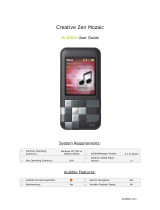
Using the wireless Amazon Whispernet service, Amazon delivers content to your Kindle
whenever you want it and to wherever you are using the same technology as a cell phone.
When you select "Shop in Kindle Store" from any menu, Kindle connects you to a broad
offering of reading material including books, newspapers, blogs, and magazines. You can
browse by category or simply check out the latest bestsellers, new and noteworthy items,
and your personalized recommendations. You can see details about an item, read
customer reviews, and even download free samples of books you are interested in. If you
want to buy an item, secure Amazon 1-Click purchasing and Whispernet delivers the item
to your Kindle in under a minute with no wireless delivery charges to you.
Automatic Delivery
Since Kindle connects to the Whispernet network, we deliver your favorite periodicals
over the air to your device as soon as they are published, often before they are even
available in print. For example, if you subscribe to the Kindle edition of The Wall Street
Journal, the latest edition is wirelessly delivered overnight so you can read it each
morning. With Whispernet's broad wireless coverage, your favorite periodicals follow
you wherever you go, whether you are at home or on the road. Also, you pay only for
your subscriptions, Amazon.com covers the wireless delivery cost.
Search Your World
The search feature can be used anywhere on Kindle; press the Search key on the
keyboard, and the Search line appears. Type in what you are looking for and select "Go".
Kindle will automatically search for the phrase in your books, newspapers, blogs,
personal documents, and annotations. It will also provide a link to The New Oxford
American Dictionary definition of the phrase you entered. You can also extend your
search to the Kindle Store, Wikipedia, and the Web.
Keep Track of Your Favorites
Have you ever been reading a book or a newspaper and wanted to clip and save a few
words to refer to later? With Kindle, simply go to the page you want to save, and select
"Save Page as Clipping" from the menu. The clipping is then added to a book in Home
called "My Clippings." You can review your clippings later, search for words or terms
you clipped, and even transfer the "My Clippings" file to your computer. This is a great
way to capture your favorite quotes and share with others.
Kindle automatically saves your place in whatever you are reading, but you can also add
a bookmark to any page by selecting the dog-eared icon at the top of the page or by
selecting "Add Bookmark" from the menu. Kindle stores all your bookmarks so you can
view them at any time by selecting "Go to Bookmark..." from the menu.
At the bottom of every page of your reading material you can see where you are by
glancing at the series of dots along the bottom of the page called the progress bar. As you

























